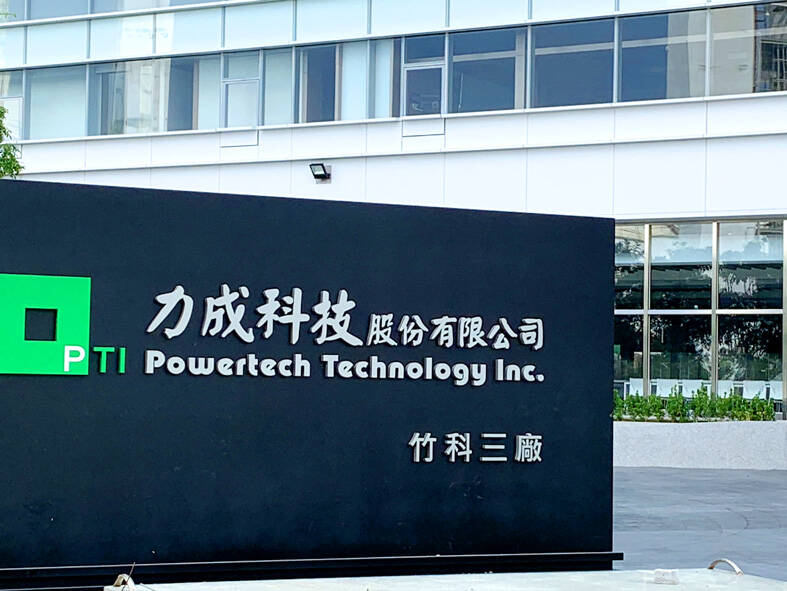Chip testing and packaging services provider Powertech Technology Inc (力成科技) yesterday said it expects revenue to rebound sequentially this quarter and next, driven by recovering demand for DRAM chips and chips used in artificial intelligence (AI) applications.
The company said the pickup in memorychip packaging and testing services would fuel growth, as customers are close to clearing their excess inventories.
In addition, the company is seeing strong demand this quarter from Micron Technology Inc, which outsources a majority of its DRAM chip packaging and testing work to Powertech, as the US firm focuses on producing high-bandwidth memory products for AI servers.

Photo: Grace Hung, Taipei Times
“We are benefiting from a long-term partnership with the company,” Powertech chief executive officer Boris Hsieh (謝永達) told investors yesterday. “Overall, we expect the second quarter to perform better than the first, and the third quarter to surpass the second.”
However, Hsieh cautioned that uncertainty surrounding US “reciprocal” tariffs poses a risk, as Washington’s tariff and trade policies could stoke inflation and weaken end-market demand.
The DRAM segment accounted for 21 percent of Powertech’s revenue in the March quarter, following the NAND flash memory segment at 24 percent and the logic chip segment at 47 percent.
Powertech also sees robust demand for logic chip packaging and testing services, driven by the rapid uptake of AI-enabled applications across sectors from PCs to cars, Hsieh said.
To meet rising demand, Greatek Electronics Inc (超豐), Powertech’s logic chip packaging and design service arm, has scrambled to expand its production capacity, Hsieh said.
Orders received by Greatek this month have surged to their highest level since the COVID-19 pandemic, as customers shift business to Greatek and other companies included on the US “whitelist,” he added.
“Rush orders are flooding in during the second quarter,” Hsieh said. “Due to uncertainty about the US’ semiconductor tariff policy, customers have proactively boosted their inventory of finished products to prepare for future policy changes.”
However, the momentum could ebb after June, as customers might become more cautious about building their inventories, he said.
The company expects AI-related revenue to increase this quarter, extending the growth momentum seen last quarter, when AI chip packaging and testing services accounted for 10 percent of total revenue, up from 8 percent in the previous quarter.
In addition, Powertech has made faster-than-expected progress in developing fan-out panel-level packaging (FOPLP) technology, achieving a better-than-anticipated yield rate, Hsieh said.
The company has outpaced industry peers, including Taiwan Semiconductor Manufacturing Co (台積電) and ASE Technology Holding Co (日月光投控), in advancing FOPLP development, he added.
Powertech yesterday reported its weakest quarterly net profit in 8 quarters, attributable to weak demand for packaging and testing services for DRAM and NAND chips.
The first quarter was the trough of the current downcycle, it said.
Net profit fell 18.1 percent to NT$1.58 billion (US$49 million), down from NT$1.93 billion in the previous quarter. Earnings per share (EPS) dropped to NT$1.58 from NT$2.04.
On an annual basis, net profit dropped 25.1 percent from NT$2.11 billion, or EPS of NT$2.32, as the company completed the divestment of its DRAM manufacturing facility in the Chinese city of Xian last year.

GROWING OWINGS: While Luxembourg and China swapped the top three spots, the US continued to be the largest exposure for Taiwan for the 41st consecutive quarter The US remained the largest debtor nation to Taiwan’s banking sector for the 41st consecutive quarter at the end of September, after local banks’ exposure to the US market rose more than 2 percent from three months earlier, the central bank said. Exposure to the US increased to US$198.896 billion, up US$4.026 billion, or 2.07 percent, from US$194.87 billion in the previous quarter, data released by the central bank showed on Friday. Of the increase, about US$1.4 billion came from banks’ investments in securitized products and interbank loans in the US, while another US$2.6 billion stemmed from trust assets, including mutual funds,

Micron Memory Taiwan Co (台灣美光), a subsidiary of US memorychip maker Micron Technology Inc, has been granted a NT$4.7 billion (US$149.5 million) subsidy under the Ministry of Economic Affairs A+ Corporate Innovation and R&D Enhancement program, the ministry said yesterday. The US memorychip maker’s program aims to back the development of high-performance and high-bandwidth memory chips with a total budget of NT$11.75 billion, the ministry said. Aside from the government funding, Micron is to inject the remaining investment of NT$7.06 billion as the company applied to participate the government’s Global Innovation Partnership Program to deepen technology cooperation, a ministry official told the

Taiwan Semiconductor Manufacturing Co (TSMC, 台積電), the world’s leading advanced chipmaker, officially began volume production of its 2-nanometer chips in the fourth quarter of this year, according to a recent update on the company’s Web site. The low-key announcement confirms that TSMC, the go-to chipmaker for artificial intelligence (AI) hardware providers Nvidia Corp and iPhone maker Apple Inc, met its original roadmap for the next-generation technology. Production is currently centered at Fab 22 in Kaohsiung, utilizing the company’s first-generation nanosheet transistor technology. The new architecture achieves “full-node strides in performance and power consumption,” TSMC said. The company described the 2nm process as

JOINT EFFORTS: MediaTek would partner with Denso to develop custom chips to support the car-part specialist company’s driver-assist systems in an expanding market MediaTek Inc (聯發科), the world’s largest mobile phone chip designer, yesterday said it is working closely with Japan’s Denso Corp to build a custom automotive system-on-chip (SoC) solution tailored for advanced driver-assistance systems and cockpit systems, adding another customer to its new application-specific IC (ASIC) business. This effort merges Denso’s automotive-grade safety expertise and deep vehicle integration with MediaTek’s technologies cultivated through the development of Media- Tek’s Dimensity AX, leveraging efficient, high-performance SoCs and artificial intelligence (AI) capabilities to offer a scalable, production-ready platform for next-generation driver assistance, the company said in a statement yesterday. “Through this collaboration, we are bringing two